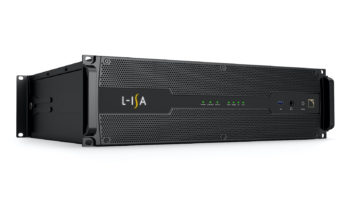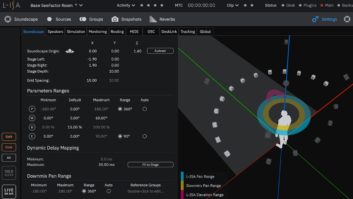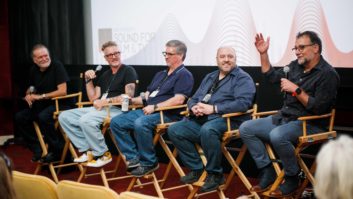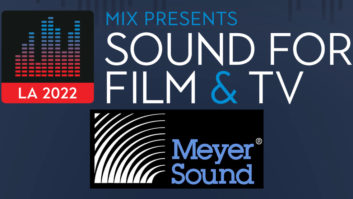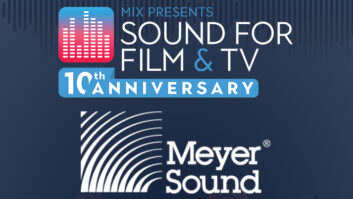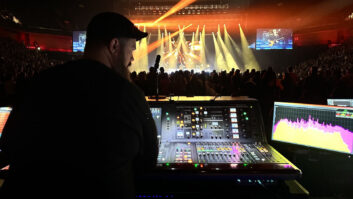“I think that, sometimes, the most simple tune can unlock so much more than anything else in picture, just in the right spot,” declares musician and composer Lisa Gerrard. “I don’t think it’s about being a great composer or an amazing musician or anything like that. I’m none of those things. If you’re able to feel, and if you’re willing to allow yourself to really sit in front of the characters and feel what they’re experiencing — and watch them and look into their faces and their hands, and look around the picture — it will start to translate itself in music through you. It will.”
While some prolific Hollywood composers pump out music at an assembly-line pace, evoking clichés and pedestrian sentiments, Australian native Lisa Gerrard has followed a special and unique path in the world of film scoring. It’s an area she immersed herself in following the dissolution of her long-running group with Brendan Perry: the revered and uncategorizable Dead Can Dance, an ensemble that cross-pollinated everything from pop and folk to Middle Eastern and early music. Since then, Gerrard has imported her unique musical sensibilities into an arena dominated by symphonic and rock sounds, while retaining her idealism and artistic identity in the face of Tinseltown orthodoxy.
Over the past three-and-a-half years, Gerrard has contributed music to Ridley Scott’s Gladiator, Michael Mann’s The Insider and Ali, and Niki Caro’s directorial debut Whale Rider. (Mann had previously used one of her original pieces for his 1995 film Heat.) Her involvement in each score has been special, for Gerrard colors her work differently than other Hollywood composers. To hear her heavenly voice and delicate, yang chin playing waft into cinemas during Gladiator was magical. Ali expanded her aural palette as she and Pieter Bourke explored jazzier atmospheres, although they still managed to sneak in one of their trademark drone and percussion pieces.
“I’m really enjoying it,” Gerrard remarks of her current career path. Her most recent score, for the independent New Zealand film Whale Rider, was liberating for the singer/musician because it was her first attempt at composing a film score solo. Previously, she had collaborated on scores with percussionist and longtime associate Bourke, who has toured with Dead Can Dance and with whom she recorded the 1998 album Duality. Whale Rider was also her first time scoring a picture entirely from scratch and without temp music.
“She’s really brilliant,” Gerrard says of director Caro. “They’ve given me the whole film, which I’ve never had before. In Hollywood, you’re always given little bits and pieces, and it’s really hard sometimes to figure out the continuity factor. I’ve got the whole film, and I can really get into the subtext and really understand which parts of the characters are linked between the different scenes musically. It’s just beautiful. I love it!”
A tale focusing on the Maori people of New Zealand, Caro’s film is “about this little girl who has this amazing affinity with whales,” explains Gerrard, “and this very difficult, complex relationship with her grandfather, who’s the head of this tribe. And this deteriorating community. It’s just exquisite. When I read the script, I said, ‘I’ve got to do this film. I don’t care how much the money is.’ I couldn’t put it down.”
Gerrard says that for Whale Rider, she has used “very low, very dark shell flutes” that are common to the Maori people. “I also used breath percussion, because I had to keep away from percussion in the film. The only percussion they play is clapping sticks. Having said that, she wants me to do a percussion piece at the end, but we’re clear of the topographic, geographic things. It’s a very emotional film, so the music is extremely exposed and extremely emotional. It’s quite haunting with these flutes. I’ve used a lot of orchestral strings and an old Maori lady singing. It’s just exquisite.”
The score for Whale Rider was composed and edited in Gerrard’s home studio with the help of her engineer Simon Bowley. Two PCs and a Macintosh work harmoniously, and she and Bowley record onto Cubase VST, utilizing GigaStudio and an Akai S5000 sampler. Her large sound library resides in GigaStudio.
“I use whatever I can get my hands on, but I always tend to go back to strings,” says Gerrard. “For different colors and various things that you might need, you use whatever works, and that can be stuff that you’ve made or things that are on CD-ROMs. You just use whatever you can to get that scene working.” Two of her favorite CD-ROMs include Bizarre Guitar and a David Torn disc. When it comes to recording live sounds (like a shell flute or a voice for Whale Rider), she uses the AKG D 12 valve mic, her “favorite piece of equipment in the world.”
The composer owns a Mackie digital 8-bus console with Version 3 software and 72 audio channels. “It takes two feeds: one from GigaStudio and [one] from VST on the two separate PCs,” explains Bowley. The Cubase PC runs NMC to control Pro Tools, “just to tell it where to start from, though Pro Tools is the master,” he says. “So if Lisa wants to go to the opening scene, she can just open up her songs, go straight to the opening scene, and that will then quickly tell Pro Tools where to jump to and then VST will follow Pro Tools. Even though it’s telling it where to start, it’s still a slave to it.”
“I’m working with the latest Pro Tools,” clarifies Gerrard. “That’s been really good for this project, because instead of downloading to DA-88s, I’ve been able to just download straight into Pro Tools. I’ve been working with QuickTime files from Pro Tools, so the whole studio is basically running together now. I can go to any part of the picture at the click of a button.”
The synchronized studio also works well for mixing and mastering. “With this project, the preliminary mix is happening on the console and then they’re bused down into groups into Pro Tools,” remarks Bowley. “Strings have their own stereo pair. What happens in the Digidesign mixer is, once you have all of the faders that you need, you’re roughly reproducing the mix [from] the Mackie console.”
Gerrard’s outboard gear includes a TC M5000, an Avalon voice module, an MPX-1 multi-effects processor and a TC Finalizer. To record vocals with the AKG, they run the signal straight into the Avalon, which then goes through an Apogee converter into a Pulsar II audio card.
The contrast between working on a high-budget studio production with frequent intrusions as opposed to a small film with greater creative freedom opened Gerrard’s eyes. “Even in Hollywood films,” she observes, “it astounds me that you give them a piece of work that they really love, and then they cut it and cut it and cut it and cut it and wonder why they don’t like it anymore. They say, ‘This piece isn’t working.’ You look at it and think, ‘What have we got left here? We have a gong and a drone.’”
Despite the fact that Gerrard found some frustration working on bigger films, she is very appreciative of the directors, particularly Mann. “I’m really happy because I got the greatest education ever in my life from director Michael Mann,” beams Gerrard. “You can’t buy an apprenticeship like I had from Michael. Michael is one of America’s finest filmmakers. I realized when I was doing [Whale Rider] how many times I reached for things that Michael has taught me.”
An important lesson Gerrard learned from Mann was trust: learning to trust a director’s vision of his/her film and how music fits into it, especially on a large-scale production. “If you don’t trust someone in a situation like that, you’re going to drown because it’s so huge and there’s so much pressure and so much work to do,” she says. “That’s what I love about this young lady [Caro] whom I’m working with at the moment. She knows what she wants. She’s a bit like Ridley Scott: He’s got the art of being able to show you what you’re doing is right or wrong without making you lose your confidence or your creative flow.”
For more information about Lisa Gerrard, visitwww.lisagerrard.com.

